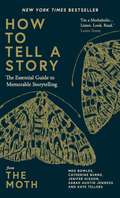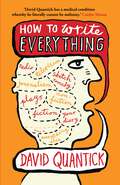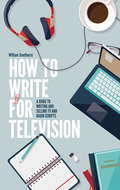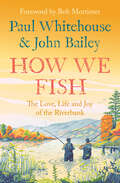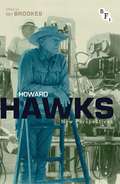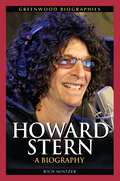- Table View
- List View
How to Tell a Story: The Essential Guide to Memorable Storytelling from The Moth
by The Moth Meg Bowles Catherine Burns Jenifer Hixson Sarah Austin Jenness Kate TellersNEW YORK TIMES BESTSELLER - The definitive guide to telling an unforgettable story in any setting, drawing on twenty-five years of experience from the storytelling experts at The MothYou are a multitude of stories. Every joy and heartbreak, every disappointment and dizzying high, has the makings of an unforgettable story. Whether your goal is to deliver the perfect wedding toast, give a moving eulogy, ace a job interview or simply connect more deeply to those around you, The Moth is here to help. A leader in the modern storytelling movement, The Moth inspires thousands of people around the globe to share their stories each year.In this book, the Moth team reveal the secrets of their time-honed process and use examples from beloved storytellers like Neil Gaiman, Elizabeth Gilbert, Nikesh Shukla, Sarfraz Manzoor and more, to show you how to:* mine your memories for your best stories* explore structures that will boost the impact of your story* deliver your stories with confidence* tailor your stories for any occasionFilled with empowering, easy-to-follow tips, this book will help you to unleash the power of storytelling on your life.
How to Work the Film & TV Markets: A Guide for Content Creators
by Heather HaleHow to Work the Film & TV Markets takes independent filmmakers, television and digital content creators on a virtual tour of the entertainment industry’s trade shows — the circulatory system of the entire global media landscape. This book highlights the most significant annual events around the world, details a dossier of all the players that frequent them and examines all the elements that drive the market value and profitability of entertainment properties. In-the-trenches insights from our modern, real-world marketplace are contextualized into immediately implementable practical advice. Make the most of your finite investments of funds, time and creative energy to optimize your odds for success within the mainstream, business-to-business circuit but learn how to select, apply and scale prudent, proven principles to drive your own Do-It-Yourself/Direct-to-the-Consuming-Crowd fundraising, distribution and promotional success. Heather Hale demystifies these markets, making them less intimidating, less confusing and less overwhelming. She shows you how to navigate these events, making them far more accessible, productive — and fun! This creative guide offers: An in-depth survey of the most significant film, TV and digital content trade shows around the world; An overview of the co-production market circuit that offers financing and development support to independent producers; An outline of the market-like festivals and key awards shows; A breakdown of who’s who at all these events — and how to network with them; Hot Tips on how to prepare for, execute and follow up on these prime opportunities; Low-budget key art samples and game plans; A social media speed tour with a wealth of audience engagement ideas. Visit the book’s space on www.HeatherHale.com for additional resources and up-to-date information on all these events.
How to Work the Film & TV Markets: A Guide for Content Creators
by Heather HaleHow to Work the Film & TV Markets takes independent filmmakers, television and digital content creators on a virtual tour of the entertainment industry’s trade shows — the circulatory system of the entire global media landscape. This book highlights the most significant annual events around the world, details a dossier of all the players that frequent them and examines all the elements that drive the market value and profitability of entertainment properties. In-the-trenches insights from our modern, real-world marketplace are contextualized into immediately implementable practical advice. Make the most of your finite investments of funds, time and creative energy to optimize your odds for success within the mainstream, business-to-business circuit but learn how to select, apply and scale prudent, proven principles to drive your own Do-It-Yourself/Direct-to-the-Consuming-Crowd fundraising, distribution and promotional success. Heather Hale demystifies these markets, making them less intimidating, less confusing and less overwhelming. She shows you how to navigate these events, making them far more accessible, productive — and fun! This creative guide offers: An in-depth survey of the most significant film, TV and digital content trade shows around the world; An overview of the co-production market circuit that offers financing and development support to independent producers; An outline of the market-like festivals and key awards shows; A breakdown of who’s who at all these events — and how to network with them; Hot Tips on how to prepare for, execute and follow up on these prime opportunities; Low-budget key art samples and game plans; A social media speed tour with a wealth of audience engagement ideas. Visit the book’s space on www.HeatherHale.com for additional resources and up-to-date information on all these events.
How To Write: Revised and Expanded Edition
by Mark Evan SchwartzThere are hundreds of books on the market, all trying to teach you how to write a screenplay. Several of them are excellent and useful books. But never - until now - has there been a screenwriting manual written in the form of a screenplay.Our hero, the aspiring screenwriter Danny, is hopelessly in love with Bebe, a hot young starlet. But Bebe won't go out with Danny until he proves that he can write a brilliant screenplay for her. Helped along the way by a mysterious guide (Virgil) with seemingly magical powers, Danny travels to Screenwriting Hell to see what happens to writers who never make the grade. Virgil teaches him the tricks of the trade, the fundamental techniques that all screenwriters have to master, no matter how great their ideas. But there's something a little strange about Virgil, and Danny is never sure whether to trust him or not...As well as the screenplay itself, the book includes an introduction explaining how to get the most out of the screenplay, the log line, the synopsis, character bios, the treatment, and "The Pitch" - a short scene that shows the author pitching his screenplay to a big-shot producer.
How To Write: Revised and Expanded Edition
by Mark Evan SchwartzThere are hundreds of books on the market, all trying to teach you how to write a screenplay. Several of them are excellent and useful books. But never - until now - has there been a screenwriting manual written in the form of a screenplay.Our hero, the aspiring screenwriter Danny, is hopelessly in love with Bebe, a hot young starlet. But Bebe won't go out with Danny until he proves that he can write a brilliant screenplay for her. Helped along the way by a mysterious guide (Virgil) with seemingly magical powers, Danny travels to Screenwriting Hell to see what happens to writers who never make the grade. Virgil teaches him the tricks of the trade, the fundamental techniques that all screenwriters have to master, no matter how great their ideas. But there's something a little strange about Virgil, and Danny is never sure whether to trust him or not...As well as the screenplay itself, the book includes an introduction explaining how to get the most out of the screenplay, the log line, the synopsis, character bios, the treatment, and "The Pitch" - a short scene that shows the author pitching his screenplay to a big-shot producer.
How to Write a Pantomime: How To Write And Deliver A Successful Traditional Script (Secrets to Success)
by Lesley CookmanThere are thousands of pantomimes staged throughout the world every year, most of them in Britain. Most groups, whether they be amateur drama societies, schools, Women's Institutes or Village Hall committees are constantly on the lookout for something fresh and original. This is often a matter of economics, as professional pantomimes can be costly in terms of performing rights, let alone the cost of scripts. This book is aimed at those people who take part in this increasingly popular hobby, and at the writer who wishes to write a pantomime, either for a local group, or, indeed, for mass publication.
How to Write Everything (Oberon Modern Plays)
by David Quantick Steven ApplebyHow To Write Everything is the ultimate writer’s handbook. It tells you about every aspect of writing, from having an idea to getting the idea out into the world (and getting paid for it too). It covers everything from journalism to screen-writing, from speeches to sketches, from sitcoms to novels. With thirty years' experience as an award-winning script-writer, journalist, author and broadcaster David Quantick is ideally suited, as a writer, to write this definitive writer's guide to writing... everything.
How To Write For Television 7th Edition: A guide to writing and selling TV and radio scripts
by William SmethurstThis book provides professional tips and techniques for those wishing to break into writing for TV whether it's a soap, series drama, or situation comedy. It covers all aspects of script writing such as structure, plotting, characterization and dialogue and is packed with advice on presenting and selling scripts. It also includes a chapter specifically on writing for radio.
How to Write Great Screenplays and Get them into Production
by Linda JamesHave you got a great idea for a screenplay, but don't know how to write it visually? Then this book is for you. It will give you the vital information you need to know before you write your script; the vital techniques you need to learn when you're writing your script. But, more importantly, it will show you how to market your script after it's written. These three vitally important stages will make your script STAND OUT from the crowd. Your will learn about:- - Preparing outlines and synopses and treatments. - The Three Act Structure - Writing powerful opening scenes, and compelling scenes to follow - Techniques to make your script stand out - Writing effective dialogue - Writing a logline to use as a powerful marketing tool to interest an agent or producer. - Professional script formatting - Organisations that help screenwriters - How to copyright your work - How to market your script - The Twenty important things to check before you send out your script
How To Write A Horror Movie
by Neal BellHow to Write a Horror Movie is a close look at an always-popular (but often disrespected) genre. It focuses on the screenplay and acts as a guide to bringing scary ideas to cinematic life using examples from great (and some not-so-great) horror movies.Author Neal Bell examines how the basic tools of the scriptwriter’s trade - including structure, dialogue, humor, mood, characters, and pace – can work together to embody personal fears that will resonate strongly on screen. Screenplay examples include classic works such as 1943’s I Walked With A Zombie and recent terrifying films that have given the genre renewed attention like writer/director Jordan Peele’s critically acclaimed and financially successful Get Out. Since fear is universal, the book considers films from around the world including the ‘found-footage’ [REC] from Spain (2007), the Swedish vampire movie, Let The Right One In (2008) and the Persian-language film Under The Shadow (2016). The book provides insights into the economics of horror-movie making, and the possible future of this versatile genre. It is the ideal text for screenwriting students exploring genre and horror, and aspiring scriptwriters who have an interest in horror screenplays.
How To Write A Horror Movie
by Neal BellHow to Write a Horror Movie is a close look at an always-popular (but often disrespected) genre. It focuses on the screenplay and acts as a guide to bringing scary ideas to cinematic life using examples from great (and some not-so-great) horror movies.Author Neal Bell examines how the basic tools of the scriptwriter’s trade - including structure, dialogue, humor, mood, characters, and pace – can work together to embody personal fears that will resonate strongly on screen. Screenplay examples include classic works such as 1943’s I Walked With A Zombie and recent terrifying films that have given the genre renewed attention like writer/director Jordan Peele’s critically acclaimed and financially successful Get Out. Since fear is universal, the book considers films from around the world including the ‘found-footage’ [REC] from Spain (2007), the Swedish vampire movie, Let The Right One In (2008) and the Persian-language film Under The Shadow (2016). The book provides insights into the economics of horror-movie making, and the possible future of this versatile genre. It is the ideal text for screenwriting students exploring genre and horror, and aspiring scriptwriters who have an interest in horror screenplays.
How Video Works: From Broadcast to the Cloud
by Diana Weynand Vance PiccinHow Video Works raises the curtain on how video is created, scanned, transmitted, stored, compressed, encoded, delivered and streamed to its multitude of destinations. In today’s digital world, every content creator—individual as well as network or corporation—must understand the process of how video works in order to deliver not only the best quality video, but a digital video file with the most appropriate specifications for each particular use. This complete guide covers key stages of video development, from image capture to the final stages of delivery and archiving, as well as workflows and new technologies, including Ultra High Definition, metadata, signal monitoring, streaming and managing video files – all presented in an easy to understand way. Whether you are a professional or new video technician discovering the ins and outs of digital distribution, this book has the information you need to succeed. The updated third edition contains: • New sections on image capture as well as streaming and video workflows • A hands-on approach to using digital scopes and monitoring the video signal • Thorough explanations of managing video files, including codecs and wrappers • In-depth coverage of compression, encoding, and metadata • A complete explanation of video and audio standards, including Ultra HD • An overview of video recording and storage formats • A complete glossary of terms for video, audio and broadcast
How Video Works: From Broadcast to the Cloud
by Diana Weynand Vance PiccinHow Video Works raises the curtain on how video is created, scanned, transmitted, stored, compressed, encoded, delivered and streamed to its multitude of destinations. In today’s digital world, every content creator—individual as well as network or corporation—must understand the process of how video works in order to deliver not only the best quality video, but a digital video file with the most appropriate specifications for each particular use. This complete guide covers key stages of video development, from image capture to the final stages of delivery and archiving, as well as workflows and new technologies, including Ultra High Definition, metadata, signal monitoring, streaming and managing video files – all presented in an easy to understand way. Whether you are a professional or new video technician discovering the ins and outs of digital distribution, this book has the information you need to succeed. The updated third edition contains: • New sections on image capture as well as streaming and video workflows • A hands-on approach to using digital scopes and monitoring the video signal • Thorough explanations of managing video files, including codecs and wrappers • In-depth coverage of compression, encoding, and metadata • A complete explanation of video and audio standards, including Ultra HD • An overview of video recording and storage formats • A complete glossary of terms for video, audio and broadcast
How We Fish: The new book from the fishing brains behind the hit TV series GONE FISHING, with a Foreword by Bob Mortimer
by null Paul Whitehouse null John BaileyPaul Whitehouse and fishing expert John Bailey celebrate the timeless joy of fishing. Paul Whitehouse and John Bailey have been devout fishermen for longer than they care to remember. A hobby, past time or sport – call it what you want – they have felt the pull of the water ever since they were kids and have never missed the chance to set up on the bank and try their luck. In this wonderful book, the two fishermen collaborate to celebrate the rich tapestry that is fishing – from mentors to memories; from philosophy to modern jargon; from watercraft to becoming self-styled ‘Fishing Detectives’. Punctuated by brilliant stories, beautiful illustrations by Carys Reilly-Whitehouse, and recollections from fishing day trips past, How We Fish is the perfect tome for the veteran fisherman or the budding angler – warm, funny and rich in the wonders of the riverbank.
How We Use Stories and Why That Matters: Cultural Science in Action
by John HartleyUsing compelling examples and analysis, How We Use Stories and Why That Matters shows what the New York Shakespeare Riots tell us about class struggle, what Death Cab for Cutie tells us about media, what Kate Moss's wedding dress tells us about authorship, and how Westworld and Humans imagine very different futures for Artificial Intelligence: one based on slavery, the other on class. Together, these knowledge stories tell us about how intimate human communication is organised and used to stage organised conflict, to test the 'fighting fitness' of contending groups – provoking new stories, identities and classes along the way.This book guides the reader through the tangled undergrowth of communication and cultural expression towards a new understanding of the role of group-mediating stories at global and digital scale. It argues that media and networked systems perform and bind group identities, creating bordered fictions within which economic and political activities are made meaningful. Now that computational and global scale, big data, metadata and algorithms rule the roost even in culture, subjectivity and meaning, we need population-scale frameworks to understand individual, micro-scale sense-making practices. To achieve that, we need evolutionary and systems approaches to understand cultural performance and dynamics. The opposing universes of fact (science, knowledge, education) and fiction (entertainment, story and imagination) – so long separated into the contrasting disciplines of natural sciences and the humanities – can now be understood as part of one turbulent sphere of knowledge-production and innovation.
How We Use Stories and Why That Matters: Cultural Science in Action
by John HartleyUsing compelling examples and analysis, How We Use Stories and Why That Matters shows what the New York Shakespeare Riots tell us about class struggle, what Death Cab for Cutie tells us about media, what Kate Moss's wedding dress tells us about authorship, and how Westworld and Humans imagine very different futures for Artificial Intelligence: one based on slavery, the other on class. Together, these knowledge stories tell us about how intimate human communication is organised and used to stage organised conflict, to test the 'fighting fitness' of contending groups – provoking new stories, identities and classes along the way.This book guides the reader through the tangled undergrowth of communication and cultural expression towards a new understanding of the role of group-mediating stories at global and digital scale. It argues that media and networked systems perform and bind group identities, creating bordered fictions within which economic and political activities are made meaningful. Now that computational and global scale, big data, metadata and algorithms rule the roost even in culture, subjectivity and meaning, we need population-scale frameworks to understand individual, micro-scale sense-making practices. To achieve that, we need evolutionary and systems approaches to understand cultural performance and dynamics. The opposing universes of fact (science, knowledge, education) and fiction (entertainment, story and imagination) – so long separated into the contrasting disciplines of natural sciences and the humanities – can now be understood as part of one turbulent sphere of knowledge-production and innovation.
Howard Hawks: New Perspectives
by Ian BrookesLeading international scholars consider the films and legacy of Howard Hawks. Diverse contributions consider Hawks' work in relation to issues of gender, genre and relationships between the sexes, discuss key films including Rio Bravo, The Big Sleep and Red River, and address Hawks' visual style and the importance of musicality in his film-making.
Howard Hawks: New Perspectives
Leading international scholars consider the films and legacy of Howard Hawks. Diverse contributions consider Hawks' work in relation to issues of gender, genre and relationships between the sexes, discuss key films including Rio Bravo, The Big Sleep and Red River, and address Hawks' visual style and the importance of musicality in his film-making.
Howard Stern: A Biography (Greenwood Biographies)
by Rich MintzerThis revealing look at the life and career of Howard Stern examines his role as a champion of free speech and his amazing success at bringing his own unique brand of "reality" radio to the airwaves.First Amendment rights, particularly freedom of speech, play an integral part in all modern means of communication. Howard Stern has tested the limits and pushed the boundaries of freedom of speech to the delight of some and the disgust of others. Howard Stern: A Biography explores this long-debated topic and sheds light on how one media star has made a significant difference.Offering an engaging and insightful look at the life and career of radio's leading Shock Jock, the book explores Stern's youth, his first forays into radio, and his desire to move up in a competitive medium. Of course, it also covers his battles with the Federal Communications Commission, how he was finally able to sidestep the censors, and the significant changes the battle brought about in what is deemed acceptable on radio.
Howard Stern: A Biography (Greenwood Biographies)
by Rich MintzerThis revealing look at the life and career of Howard Stern examines his role as a champion of free speech and his amazing success at bringing his own unique brand of "reality" radio to the airwaves.First Amendment rights, particularly freedom of speech, play an integral part in all modern means of communication. Howard Stern has tested the limits and pushed the boundaries of freedom of speech to the delight of some and the disgust of others. Howard Stern: A Biography explores this long-debated topic and sheds light on how one media star has made a significant difference.Offering an engaging and insightful look at the life and career of radio's leading Shock Jock, the book explores Stern's youth, his first forays into radio, and his desire to move up in a competitive medium. Of course, it also covers his battles with the Federal Communications Commission, how he was finally able to sidestep the censors, and the significant changes the battle brought about in what is deemed acceptable on radio.
Hugh Grant: The Unauthorised Biography
by Jody TressiderHugh Grant is the quintessential English movie star. He is also a man of opposites; his easy charm belies a malicious wit and as heart throb star of Four Weddings and a Funeral he shocked the world when police found him enjoying the services of a Sunset Boulevard prostitute.Jody Tresidder, who has written this first, hugely revealing biography of Britain's most famous film star, was a teenage love of Hugh Grant's. She has uncovered all facets of the man - his boyish appeal, his glamorous relationship with Liz Hurley and the darker side that he can longer conceal.
Hum Dono: The Dev and Goldie Story
by Tanuja ChaturvediVijay & Dev were brothers. From Vijay's debut, they were inextricably wound in each film's creative process. They trusted each other implicitly, though they did have their own share of creative conflicts too. In an instance, Goldie's unease about a certain decision was echoed by Dev instinctively, in others they never saw eye to eye.The book explores what ticked for Goldie and Dev. How were creative differences resolved? How did the changing India reflect in their films? Was being brothers an advantage or a disadvantage for them? And finally, what was the unknown, the “X-factor” so to speak, which collided and coalesced between these two extraordinary people?
Human Factors in Performing Arts: A Layperson's Approach
by PRABIR MUKHOPADHYAYThis captivating book explores the intersection where performing art meets human interaction and delves into the application of human factors’ principles in this field. From music and theatre to cinema and magic shows, indoor and outdoor performances are analyzed from a human factors perspective. Written in an accessible language, this book offers a comprehensive overview of how human factors influence various facets of the performing arts, enriching the experience for both performers and audiences alike.This book uncovers how human factors principles can enhance performance across script writing, stage design, crowd engagement, and more. Through engaging storytelling and practical examples, readers will learn about the intricacies of audience attention, ambience creation, and the importance of feedback in shaping memorable performances. Whether you're a seasoned professional or an aspiring events manager looking to enhance the user experience, this book provides valuable insights into optimizing the human experience within the realm of performing arts making it safe and memorable for all.Ideal for professionals in human factors, occupational health and safety, as well as those working in the performing arts industry, Human Factors in Performing Arts: A Layperson's Approach serves as a valuable resource for theatre managers, event organizers, and anyone involved in orchestrating small or large-scale performances. With its blend of theory and real-world application, it offers a fresh perspective on human factors and the art of entertainment, making it essential reading for anyone passionate about elevating their craft.
Human Factors in Performing Arts: A Layperson's Approach
by PRABIR MUKHOPADHYAYThis captivating book explores the intersection where performing art meets human interaction and delves into the application of human factors’ principles in this field. From music and theatre to cinema and magic shows, indoor and outdoor performances are analyzed from a human factors perspective. Written in an accessible language, this book offers a comprehensive overview of how human factors influence various facets of the performing arts, enriching the experience for both performers and audiences alike.This book uncovers how human factors principles can enhance performance across script writing, stage design, crowd engagement, and more. Through engaging storytelling and practical examples, readers will learn about the intricacies of audience attention, ambience creation, and the importance of feedback in shaping memorable performances. Whether you're a seasoned professional or an aspiring events manager looking to enhance the user experience, this book provides valuable insights into optimizing the human experience within the realm of performing arts making it safe and memorable for all.Ideal for professionals in human factors, occupational health and safety, as well as those working in the performing arts industry, Human Factors in Performing Arts: A Layperson's Approach serves as a valuable resource for theatre managers, event organizers, and anyone involved in orchestrating small or large-scale performances. With its blend of theory and real-world application, it offers a fresh perspective on human factors and the art of entertainment, making it essential reading for anyone passionate about elevating their craft.
